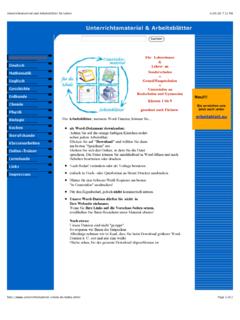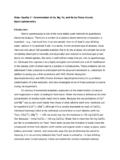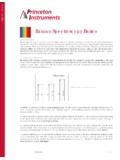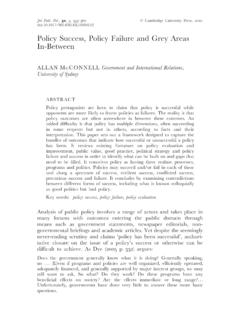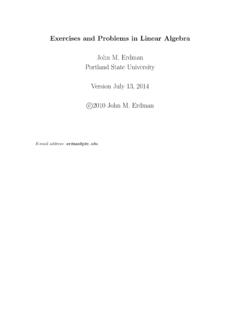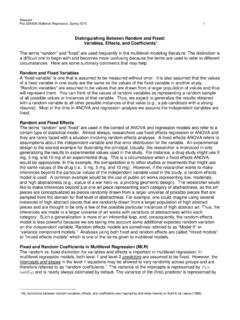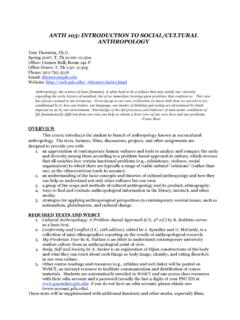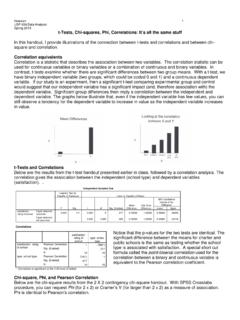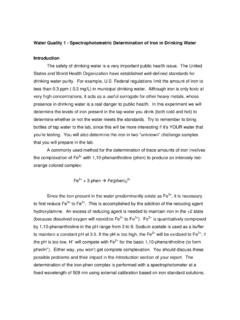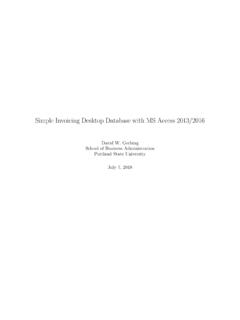Transcription of Levels of Measurement and Choosing the Correct Statistical ...
1 Newsom Psy 521/621 Univariate Quantitative Methods, Fall 2020 1 Levels of Measurement and Choosing the Correct Statistical Test Most textbooks distinguish among nominal, ordinal, interval, and ratio scales based on a classification system developed by Stevens (1946). Choice of the Statistical analyses in the social sciences typically rests on a more general or cruder classification of measures into what I will call continuous and discrete. Continuous refers to a variable with many possible values. By "discrete" I mean few categories.
2 I, as well as others, often use the terms dichotomous, binary, categorical, or qualitative synonymously with discrete. 1 This general characterization of a dependent (response) variable as discrete or continuous relates to two general classes of commonly employed Statistical tests those based on the normal distribution and those based on the binomial distribution (or its relatives, the multinomial and Poisson distributions). Normal theory plays an important role in Statistical tests with continuous dependent variables, such as t-tests, ANOVA, correlation, and regression, and binomial theory plays an important role in Statistical tests with discrete dependent variables, such as chi-square and logistic Ordinal scales with few categories (2,3, or possibly 4) and nominal measures are often classified as discrete and are analyzed using binomial class of Statistical tests, whereas ordinal scales with many categories (5 or more)
3 , interval, and ratio, are usually analyzed with the normal theory class of Statistical tests. Although the distinction is a somewhat fuzzy one, it is often a very useful distinction for Choosing the preferred Statistical test, especially when you are starting out. Type of Dependent Variable (or Scale) Level of Measurement General Class of Statistic Examples of Statistical Procedures Discrete (binary and categorical) nominal, ordinal with 2, 3, or 4 Levels Binomial (as well as multinomial and Poisson) chi-square, logistic regression Continuous ordinal with more than 4 categories, interval, ratio normal ANOVA, regression, correlation, t-tests Classifying the independent and the dependent variable as continuous or discrete will determine the type of analyses that are likely to be appropriate in a given situation.
4 Dependent Variable Discrete Continuous Independent variable Discrete (binary and categorical) Chi-square Logistic Regression Phi Cramer's V t-test ANOVA Regression Point-biserial Correlation Continuous Logistic Regression Point-biserial Correlation Regression Correlation Controversies and Common Practice There is a longstanding debate about how to classify measurements and whether Levels of Measurement can be a successful guide to the choice of data analysis type ( , Borgatta & Bohrnstedt, 1980; Michell, 1986; Townsend & Ashby, 1984; see Hayes & Embretson, 2012; Scholten & Borsboom, 2009 for recent discussions of the controversy).
5 3 In my view, there are two relevant issues that should 1 Mathematicians will define discrete variables more generally in a way that will include many if not most of the variables that social scientists view as continuous in common practice. For example, Hays (1994) gives If a random variable can assume only a particular finite or a countably infinite set of values, it is said to be a discrete random variable. (p. 98) 2 As we will discover later, the Pearson chi-square test really uses a normal distribution as an approximation, but the binomial (or multinomial) distribution is central to most statistics used with categorical dependent variables.
6 I have placed chi-square with the binomial theory class of statistics, therefore, because the normal distribution is really just used as an efficient substitute for the binomial distribution. 3 My intention is not to try to resolve the debate, but to offer a general simple heuristic as a starting place for deciding which type of analysis is used in common practice in the social sciences for general types of dependent variables. In reality, there are a number of other factors that Newsom Psy 521/621 Univariate Quantitative Methods, Fall 2020 2 be distinguished from one another.
7 The first issue is a more philosophical concern about whether psychological (or other social) phenomena can be reliably and validly represented by numeric ordinal data. I happen to believe that there is a wealth of psychometric research that has already established this to be the case ( , Bendig, 1954; Symonds, 1924; Matell & Jacoby, 1971), but I will leave this controversy to those more qualified to consider deep epistemological dilemmas (which are, frankly, often over my head). The second issue is more of an empirical or Statistical question about whether scales, such as Likert-type scales, with some sufficient number of several ordinal response options will provide accurate results when normal distribution Statistical tests ( , t-tests, ANOVA, OLS regression) are used.
8 There seems to be fairly good evidence from simulation studies that suggests that if there are 5 or more ordered categories there is relatively little harm in treating these ordinal variables as continuous ( , Johnson & Creech, 1983; Muth n & Kaplan, 1985; Zumbo & Zimmerman, 1993; Taylor, West, & Aiken, 2006). There appears to be added benefit to additional ordinal values up to some point (at least to 7- or 9-point scales). Note that this distinction applies to the dependent variable used in the analysis to the response categories used in a survey whenever multiple items are combined ( , by computing the mean or sum) a composite measure that will have many values and will usually be considered continuous.
9 There are other concerns that are important, such as the distribution of the variable. Normal distribution statistics, such as OLS regression and ANOVA, are remarkably robust to small or moderate departures from normality if sample sizes are even moderate ( , N = 20-40; Myers, Well, & Lorch, 2010; Stonehouse & Forrester, 1998), more substantial departures can usually be addressed with robust approaches ( , robust standard errors in regression or structural modeling, bootstrap estimates). When sample sizes are small and distributions are highly nonnormal, nonparametric tests ( , Mann-Whitney U test, Kruskal-Wallis ANOVA) may be optimal (see Sheskin, 2011, for an extensive list).
10 Ordinal Analyses The contrast between discrete and continuous variables is an oversimplification. There really is a big gray area when there are 3 or 4 ordinal categories. Although in practice, most researchers only tend to use binomial and normal theory statistics, there is another class of Statistical tests specifically designed for ordinal scales that are becoming increasingly available in software packages. There are several excellent references for ordinal Statistical tests (Agresti, 1984, 2002; Cliff, 1996; Wickens, 1989). For regression models, Long s (1997) book is a very good, although technical, treatment.
